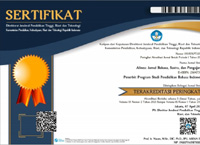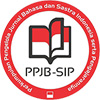Keterbacaan Teks Kesehatan dalam Website WHO pada Masa Pandemi Covid-19
Abstract
Artikel ini akan membahas keterbacaan teks-teks kesehatan yang dirilis oleh WHO yang berkaitan erat dengan pandemi Covid-19. Melalui metode deskriptif kualitatif, formula Gunning Fog Index digunakan untuk menentukan tingkat keterbacaan melalui prosedur pencocokkan hasil perolehan nilai Fog Index dengan tabel Estimated Reading Grades berdasarkan teori Heydari. Sumber data penelitian berupa empat artikel berbahasa Inggris. Analisis data mengggunakan teori Grammatical Intricacy (GI) dan Lexical Density (LD) yang menitikberatkan pada kerumitan tata bahasa serta kepadatan diksi melalui pemanfaatan text analyzer. Berdasarkan hasil analisis, tingkat keterbacaan teks kesehatan pada website resmi WHO di masa pandemi COVID-19 dikategorikan sebagai teks dengan kesulitan cukup tinggi untuk dipahami dengan skor LD rata-rata 52,55% dan skor rata-rata Fog Index mencapai 12,55. Target pembaca untuk teks ini disarankan adalah masyarakat dengan minimal pendidikan sekolah menengah ke atas agar teks dapat dipahami dengan tepat.
Kata kunci:Â COVID-19, tingkat keterbacaan, teks kesehatan, SFL
This article will discuss the readability of health articles published by WHO on which relates to the current COVID-19. Through the qualitative descriptive methodology, the Gunning Fog Index formula is used to determine the readability through the procedure of matching the Fog index results with Heydari’s theory on Estimated Reading Grades. This research takes four main articles written in English as the data. Data analysis by using the theory of Grammatical Intricacy and Lexical Density using text analyzer website. The results show that the health articles published by WHO during the pandemic are difficult to read by the targeted readers as the average LD score shows 52,55% and the average Fog Index score is 12,55. The targeted readers for these texts are those with minimum high school educational background to ensure that the content of the text is correctly understood.
Keywords: COVID-19, readability, health articles, SFL
Full Text:
PDFReferences
Anjarkusuma, Dewangga, et al. “Penggunaan Aplikasi CMS Wordpress untuk Merancang Website Sebagai Media Promosi pada Maroon Wedding Malang.†Jurnal Akuntansi, Ekonomi, dan Manajemen Bisnis, vol. 2, no. 1, 2014, p. 63, http://herrypernando.blogspot.com.
Apriananta, Yosua Jefri, and Lina Sinatra Wijaya. “Penggunaan Website dan Media Sosial dalam Membangun Citra Positif Perguruan Tinggi.†Jurnal Komunikatif, vol. 7, no. 2, 2018, pp. 187–209, doi:10.33508/jk.v7i2.1750.
Benjamin, Rebekah George. “Reconstructing Readability: Recent Developments and Recommendations in the Analysis of Text Difficulty.†Educational Psychology Review, vol. 24, no. 1, 2012, pp. 63–88, doi:10.1007/s10648-011-9181-8.
DuBay, William H. “The Principles of Readability: A Brief Introduction to Readability Research.†Impact Information, no. 949, 2004, pp. 1–72, http://scholar.google.com/scholar?hl=en&btnG=Search&q=intitle:The+Principles+of+Readability#1.
Greenfield, Jerry. “Readability Formulas For EFL.†JALT Journal, vol. 26, no. 1, 2004, p. 5, doi:10.37546/jaltjj26.1-1.
Haliday, M.A.K., Matthiessen, C. M. I. M. An Introduction to Functional Grammar. Third, Hodder Arnold, 2014.
Hidayat, Taufik. “Trend Teknologi Revolusi Industri 4.0.†Direktorat Sistem Informasi Dan Teknologi UNIDA, 2019, https://www.unida.ac.id/teknologi/artikel/trend-teknologi-revolusi-industri-40.html#:~:text=Revolusi Industri 4.0 merupakan sebuah,model bisnis baru berbasis digital.
Humphreys, Alexandra H., et al. “Reading Difficulty Levels of Selected Articles in the Journal of Research in Music Education and Journal of Historical Research in Music Education.†Music Education Research International, vol. 6, 2013, pp. 15–25.
Muharam, Masyhar, and Andhika Giri Persada. “Implementasi Penggunaan Website Sebagai Media Informasi dan Media Pemasaran Hasil Pertanian dan Peternakan Desa Sumberejo.†Automata, vol. 1, no. 2, 2020, www.desasumberejo.com.
Suherli. Keterbacaan Buku Teks Pelajaran. 2008, http://suherlicentre.blogspot.com/2008/07/keterbacaan-buku-teks-pelajaran.html.
Sujatna, Eva Tuckyta Sari. “Readability of the Transactional Texts in Bahasa Inggris Textbook for Grade X.†International Journal of Systemic Functional Linguistics, vol. 2, no. 1, 2019, pp. 33–42, https://ejournal.warmadewa.ac.id/index.php/ijsfl.
Sutopo, HB. Metode Penelitian Kualitatif. UNS Press, 2006.
Yulianto. “An Analysis on Readability Level of English Reading Texts for Eighth Grade Students.†Journal of English for Academic, vol. 6, no. 1, 2019, pp. 81–91.
Zakaluk, Beverley L., and S. Jay Samuels. Readibility: Its Past, Present, and Future. 1988.
Zamanian, Mostafa, and Pooneh Heydari. “Readability of Texts: State of the Art.†Theory and Practice in Language Studies, vol. 2, no. 1, 2012, pp. 43–53, doi:10.4304/tpls.2.1.43-53.
DOI: https://doi.org/10.35194/alinea.v10i2.1479
Refbacks
- There are currently no refbacks.
Alinea: Jurnal Bahasa, Sastra, dan Pengajaran indexed and suported by:

This work is licensed under a Creative Commons Attribution-ShareAlike 4.0 International License.








